Kneel at the threshold of David's Tabernacle, where ancient worship and divine mysteries beckon the curious to uncover its sacred legacy.
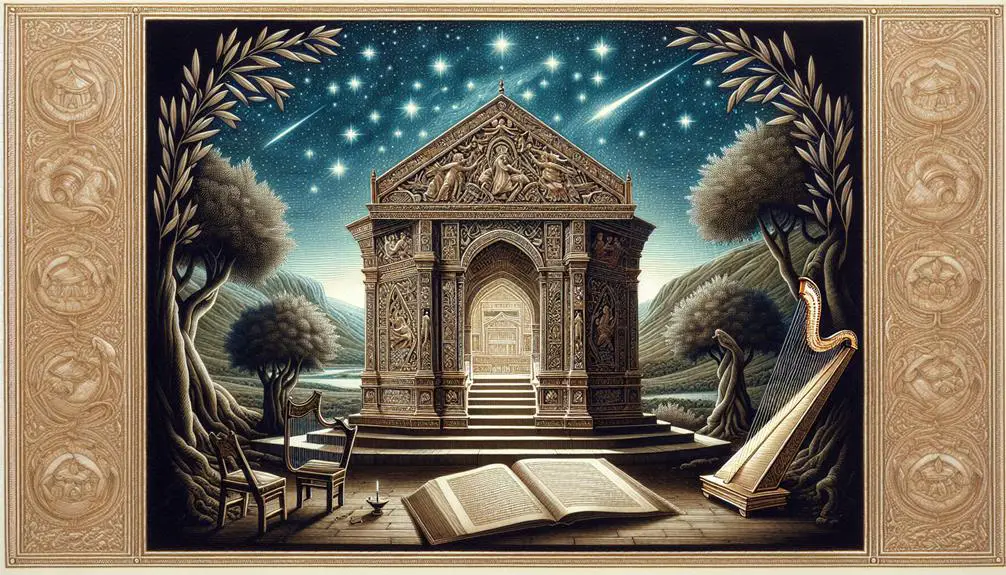
David's Tabernacle in the Bible
In the tapestry of biblical history, David's Tabernacle stands as a vibrant thread, weaving together worship, politics, and divine presence. You'll find its design and structure more than just architectural feats; they symbolize an era of transition and spiritual fervor.
As you explore the historical context, the rituals performed, and the ark's pivotal role, you're invited to compare it with Solomon's Temple and reflect on its enduring legacy. This journey through ancient texts and interpretations might just shift your understanding of worship and community in the biblical narrative.
Why did this structure capture God's favor, and what can its legacy teach us today?
Key Takeaways
- David's Tabernacle symbolized faith, unity, and the centralization of worship in Jerusalem, strengthening national identity.
- The design and structure of the Tabernacle, from its colors to materials, carried deep theological and spiritual significance.
- Worship within the Tabernacle incorporated music and sacrificial offerings, emphasizing both joyous celebration and solemn submission to the divine.
- The Ark's presence in the Tabernacle represented God's covenant with Israel, anchoring the nation's spiritual identity and divine guidance.
Historical Context
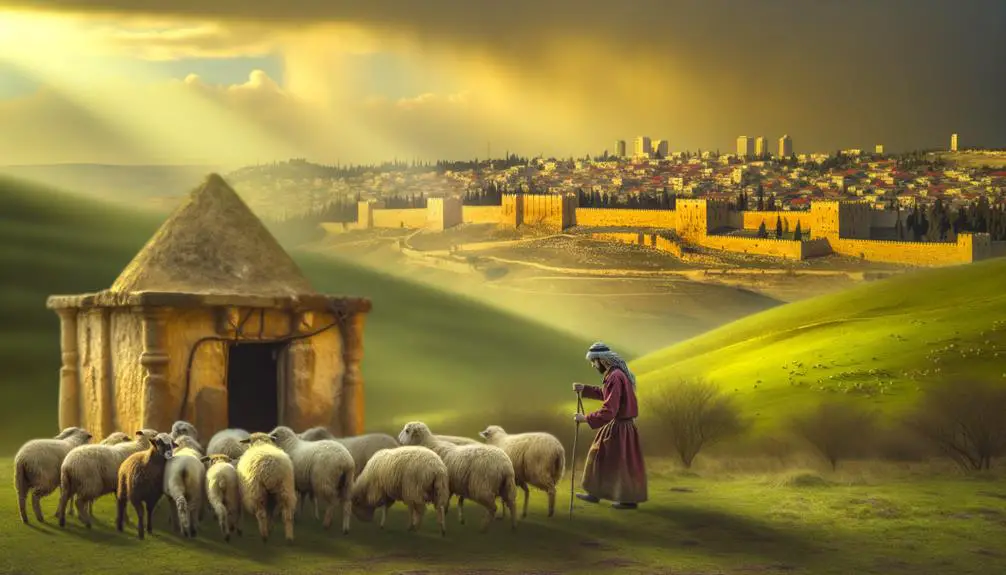
To understand David's Tabernacle fully, it's crucial to delve into its historical context, which reveals its significance in ancient Israelite worship and society. Situating this structure within King David's reign, you'll uncover its pivotal role not only in religious practices but also in solidifying the unity of the Israelite tribes under a central monarchy. King David, a central figure in Biblical narratives, sought to establish a unifying symbol of faith and national identity. His efforts to bring the Ark of the Covenant to Jerusalem, as recorded in the scriptures, underscored his dedication to centralizing religious worship, which was a strategic move to fortify his political authority and foster a sense of common identity among the diverse tribes of Israel.
The historical backdrop of David's Tabernacle is intertwined with the socio-political landscape of the time. David's decision to erect this structure wasn't merely a religious act but a calculated political strategy. By choosing Jerusalem as the site for the Tabernacle, David was asserting the city's importance as the religious and political heart of the united kingdom. This action reinforced his legitimacy as ruler and played a critical role in the development of Jerusalem as the capital of Israel.
In examining the historical context of David's Tabernacle, you're engaging with a complex narrative that blends religious devotion, political savvy, and cultural integration. This exploration reveals how the Tabernacle functioned as a symbol of unity and continuity, bridging the gap between the nomadic traditions of the Israelites and the establishment of a permanent monarchy.
Design and Structure
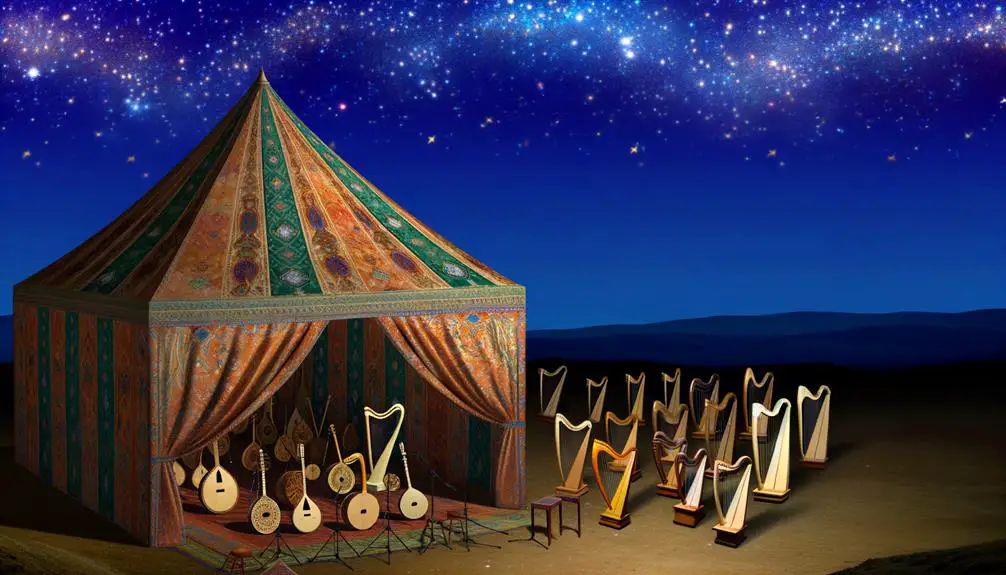
You must now turn your attention to the intricate design and structure of David's Tabernacle, particularly focusing on the tent layout and the significance of the Ark's placement. The arrangement within the tent reveals much about the liturgical practices and theological symbolism of the time.
Analyzing the spatial organization offers insights into the broader cultural and religious contexts of ancient Israel.
Tent Layout Details
Analyzing the tent layout of David's Tabernacle reveals a meticulous design and structure, aimed at facilitating both worship and community gatherings. The selection of fabric colors wasn't merely aesthetic but symbolic, reflecting theological and cultural significances. Reds symbolized blood and sacrifice, purples denoted royalty and God's sovereignty, while blues represented the heavens and divine revelation. These colors weren't chosen randomly but were deeply embedded in the fabric of Israelite worship practices.
The construction materials further underscored this sanctity. Acacia wood, known for its durability and resistance to decay, served as the primary structural material, symbolizing the enduring nature of faith. Linens, fine and pure, represented righteousness. Together, these elements didn't just create a physical space but a deeply spiritual one, where every detail spoke volumes about worship and divine presence.
Ark Placement Significance
The placement of the Ark within David's Tabernacle wasn't merely a matter of tradition but a deliberate design choice reflecting deep theological and structural significance.
You'll find that the Ark's mobility, often emphasized in biblical narratives, underscored its role as a symbol of God's presence amidst His people. This mobility wasn't just practical; it carried profound political implications.
By positioning the Ark centrally within the Tabernacle, David was asserting a unifying national identity under divine sovereignty, transcending tribal divisions. This strategic placement also facilitated the Ark's movement, embodying the concept of a God who isn't static but moves among and interacts with His people.
The design choice, therefore, was a masterful blend of theology, politics, and community, encapsulating the essence of Davidic leadership and divine covenant.
Worship and Rituals
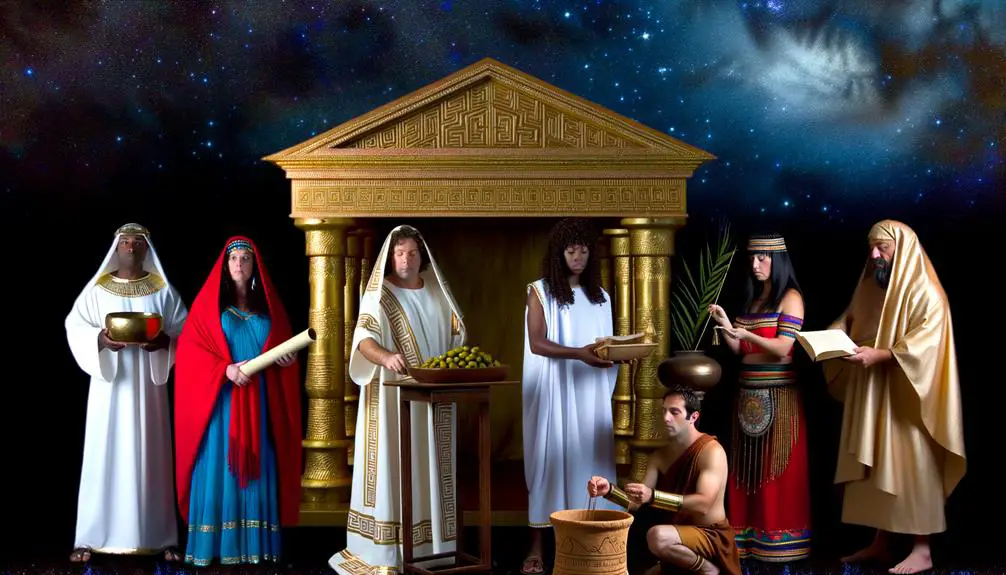
Within David's Tabernacle, worship and rituals played a pivotal role, embodying both the spiritual ethos and communal identity of the period. At the heart of these practices were musical instruments and sacrificial offerings, each serving a distinct purpose in the religious life of the community.
Musical instruments, ranging from harps and lyres to cymbals and trumpets, weren't just accompaniments but were integral to the act of worship. They facilitated a deep, communal connection to the divine, transcending the spoken word to express the inexpressible. The use of music in the tabernacle underscored the importance of joy, celebration, and reverence in approaching the sacred. It was a reflection of the belief that worship wasn't merely about duty or tradition but about fostering a vibrant, emotional connection with God.
Sacrificial offerings, on the other hand, symbolized a different aspect of worship. They represented submission, atonement, and gratitude. Through these offerings—whether grain, incense, or burnt sacrifices—worshipers engaged in a tangible act of devotion, acknowledging their reliance on and responsibility to the divine. This practice underscored a communal ethos of humility and repentance, essential for maintaining a harmonious relationship with God.
Together, musical expressions and sacrificial rituals within David's Tabernacle encapsulated a multifaceted approach to worship. They highlighted the community's desire not only to honor their covenant with God but to experience His presence in a deeply personal and communal way. This dual emphasis on joyous celebration and solemn submission continues to influence contemporary understandings of spiritual worship.
The Ark's Significance
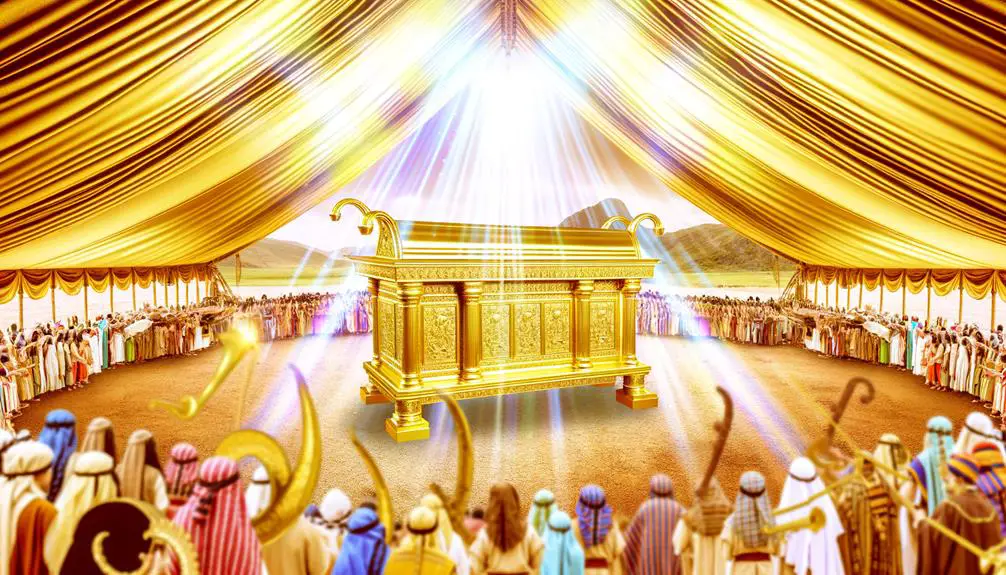
You must understand that the Ark's role extended beyond a mere artifact; it served as a tangible symbol of God's presence among His people.
As the focal point of worship activities within David's Tabernacle, its significance was unparalleled, embodying the central location where the divine and human realms met.
Moreover, it represented the covenant between God and Israel, a perpetual reminder of their sacred bond and mutual commitments.
Symbol of God's Presence
Understanding the Ark's significance reveals its role as not just a sacred object, but as a profound symbol of God's omnipresence and covenant with His people. This emblem of divine presence was central in the narratives of divine encounters and spiritual pilgrimage, embodying a multifaceted symbolism:
- Manifestation of God's Presence: It served as a tangible sign of God's immediate presence among His followers.
- Covenantal Symbol: Represented the unbreakable promise between God and His people.
- Guidance and Protection: Symbolized God's guidance and protection on their journeys.
- Holiness and Purity: Demanded respect and purity from those who approached it, reinforcing the holiness required in God's presence.
Through these aspects, the Ark underscored the intimate relationship between the divine and the devout, anchoring the spiritual identity of a nation.
Center of Worship Activities
Serving as the epicenter of worship activities, the Ark's significance extends beyond its physical presence, embodying the core of communal and individual spiritual engagement. It catalyzed musical innovations and redefined leadership roles within the religious community.
Aspect |
Impact on Worship |
Connection to the Ark |
|---|---|---|
Musical Innovations |
Introduced new forms of worship music |
Inspired by the Ark's presence |
Leadership Roles |
Shifted to more spiritual guidance |
Centered around the Ark's symbolism |
Community Engagement |
Fostered a unified spiritual identity |
Anchored by the Ark's location |
These elements underscore the Ark's pivotal role in shaping the worship practices of David's time, merging traditional beliefs with innovative expressions of faith, and establishing a blueprint for future generations.
Covenant Representation
Exploring beyond its role as the center of worship activities, the Ark's significance also embodies the covenant between God and His people, serving as a tangible symbol of divine promises and guidance. This covenant representation unfolds through:
- Marital Imagery: The Ark symbolizes a marital contract, signifying an indissoluble union between God and Israel. This imagery underscores the intimacy and commitment inherent in the covenant.
- Prophetic Implications: It harbors messianic expectations, pointing to a future fulfillment of God's promises.
- Divine Presence: The Ark's location in the Tabernacle serves as a constant reminder of God's immediate presence among His people.
- Law and Guidance: Housing the Ten Commandments, it represents God's law as the guiding principle of the covenant relationship.
This multifaceted significance reinforces the Ark's role in conveying the depth of the covenantal relationship between God and His people.
Comparisons With Solomon's Temple
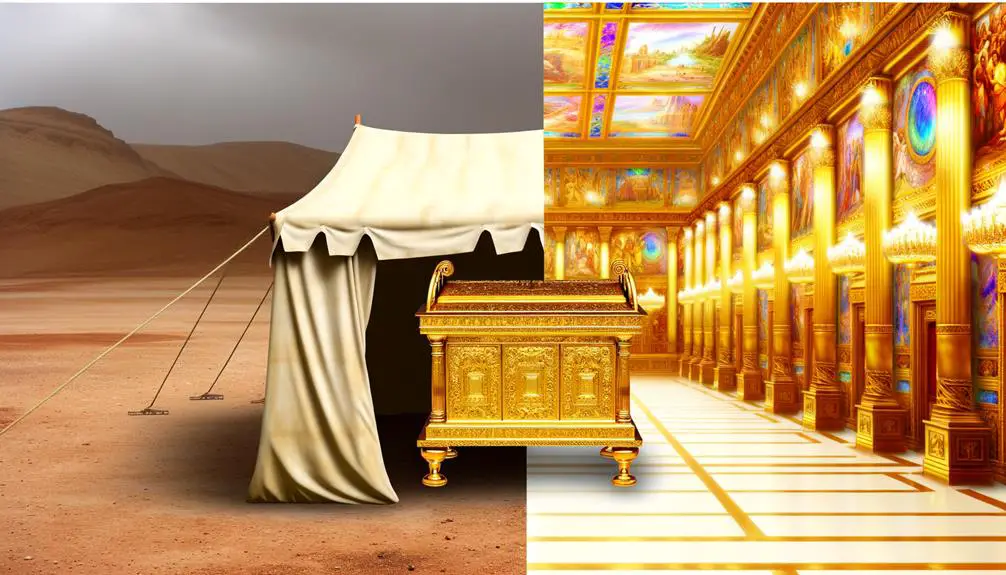
Comparing David's Tabernacle to Solomon's Temple reveals fundamental differences in structure, purpose, and religious significance. Delving into the financial implications of both, you'll find that Solomon's Temple demanded a significantly larger economic outlay. This disparity in cost stems largely from the construction materials used. David's Tabernacle, primarily a tent structure, relied on fabrics and animal skins, materials that were relatively easy to acquire and handle.
In contrast, Solomon's Temple was a monumental undertaking, crafted from expensive materials like cedar wood from Lebanon, gold, bronze, and stone. These choices not only elevated the temple's aesthetic and durability but also its cost, reflecting its intended permanence and the wealth of the kingdom at that time.
Moreover, the purpose behind each structure diverges. David's Tabernacle served as a more mobile, temporary dwelling for the Ark of the Covenant, aligning with the nomadic lifestyle of the Israelites during David's reign. Solomon's Temple, however, symbolized a permanent residence for God's presence, underscoring a shift towards a settled, urban society under Solomon's rule.
The religious significance of each also differs. David's Tabernacle is often seen as a humble approach to worshipping God, emphasizing faith and devotion over grandeur. Solomon's Temple, by contrast, represented the zenith of Israelite religious architecture, a tangible manifestation of the nation's prosperity and its complex relationship with God.
These differences highlight the evolution of Israelite society and religious practices, from the simplicity of David's era to the complexity and splendor of Solomon's reign.
Legacy and Modern Interpretations
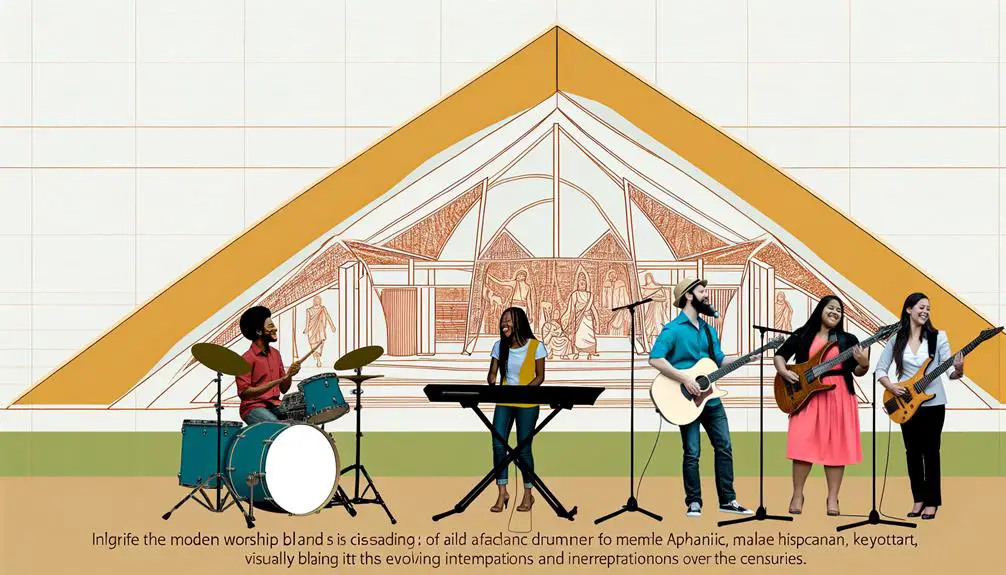
The legacy of David's Tabernacle and its modern interpretations resonate deeply within contemporary religious and historical discourse. You'll find that its significance extends far beyond ancient texts, influencing both cultural perspectives and architectural designs in profound ways. To truly appreciate the breadth of its impact, consider the following aspects:
- Cultural Impact: David's Tabernacle has become a symbol of divine presence and worship, deeply rooted in the collective consciousness of several religious communities. Its representation in music, literature, and art underscores its lasting relevance, serving as a reminder of the spiritual connection and devotion exemplified by David.
- Architectural Influence: The structure of David's Tabernacle has inspired modern church designs, emphasizing simplicity, functionality, and a central space for worship. Architects often reference its design principles, aiming to capture the essence of sacred space that facilitates communal gatherings and personal reflection.
- Theological Interpretations: Scholars and theologians continue to debate the tabernacle's significance, viewing it as a precursor to the Temple and a manifestation of God's mobility and accessibility. This has led to diverse theological perspectives on worship practices and the nature of sacred spaces.
- Educational Value: The study of David's Tabernacle offers invaluable insights into ancient religious practices, societal norms, and architectural techniques. It serves as a critical case study in religious studies, history, and anthropology courses, highlighting the interconnectedness of faith, culture, and art.
Frequently Asked Questions
How Has the Concept of David's Tabernacle Influenced Contemporary Music and Worship Practices in Different Religious Traditions?
You're seeing how musical genres and instrument innovation have evolved in contemporary worship, drawing from a rich tradition. This influence shapes the creation and performance of music across various religious practices today.
Are There Any Archaeological Findings That Directly Link to the Existence of David's Tabernacle, and How Do Scholars Interpret These Findings?
You're delving into the past, where site excavations and historical methodologies bring ancient tales to life. Unfortunately, there aren't direct archaeological findings that conclusively link to the existence of a specific ancient structure.
Scholars interpret these findings with caution, balancing between historical texts and physical evidence. Their analysis often reveals more about the people and culture than the existence of particular buildings, leaving some questions intriguingly unanswered.
How Do Various Christian Denominations Interpret the Symbolism of David's Tabernacle in Their Theology and Liturgy?
You're exploring how Christian denominations draw upon David's Tabernacle's symbolism in their theology and liturgy. They delve into the tabernacle's sacrificial practices and liturgical garments, interpreting them as metaphors for Christ's sacrifice and the priesthood's role. This analysis enriches their worship and understanding of biblical precedents.
What Are the Lesser-Known Myths or Folklore Surrounding David's Tabernacle That Are Not Commonly Discussed in Academic or Religious Texts?
You're delving into the depths of lesser-known lore, seeking stories scarcely spoken. Tabernacle tales teem with mythical interpretations, yet many remain shrouded in shadows, untouched by typical theological texts.
This quest uncovers arcane anecdotes, exploring enigmatic elements embedded in traditions. As you analyze these accounts, remember, they're not just myths but reflections of rich, cultural undercurrents, offering unique insights into the shared human experience beyond conventional religious narratives.
How Has the Depiction of David's Tabernacle in Art and Literature Evolved Over the Centuries, and What Impact Has This Had on Popular Understanding of Its Significance?
The depiction of David's Tabernacle in art and literature has evolved significantly, influenced by artistic trends and cultural interpretations. This evolution has deeply impacted your understanding of its significance.
As styles and societal values shifted, so did portrayals, moving from literal interpretations to more abstract or symbolic ones. This change hasn't only reflected but also shaped popular perceptions, enriching the narrative around this ancient structure with diverse layers of meaning.
Conclusion
In analyzing David's Tabernacle, you've traversed ancient paths, discovering its unique design and intricate worship rituals, contrasting sharply with Solomon's grand Temple. The Ark's central role underscored its sanctity, bridging heaven and earth.
Yet, this journey reveals more than historical relics; it uncovers a legacy of faith, a blueprint of divine fellowship. Through modern interpretations, David's Tabernacle persists, not merely as an architectural feat but as a symbol of enduring spiritual pursuit, inviting reflection and emulation in contemporary faith practices.

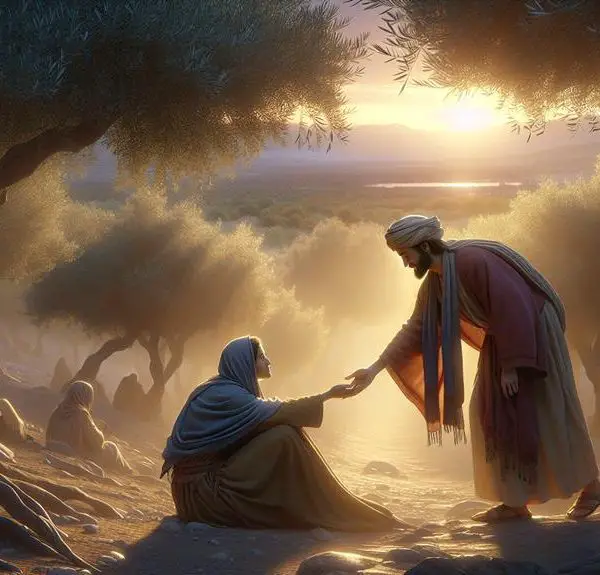

Sign up